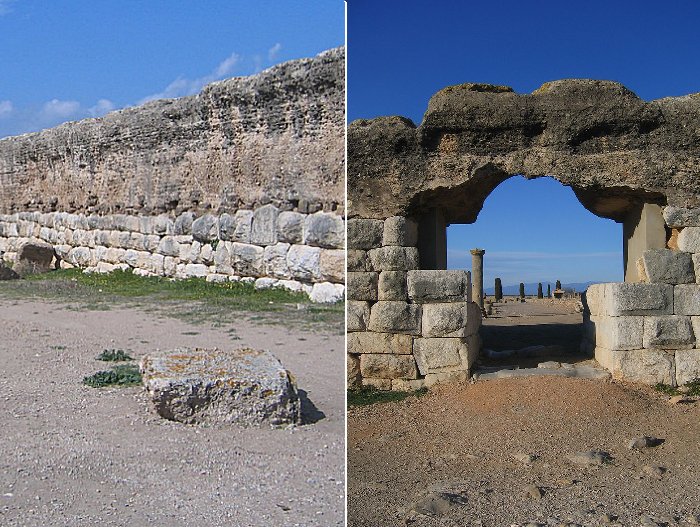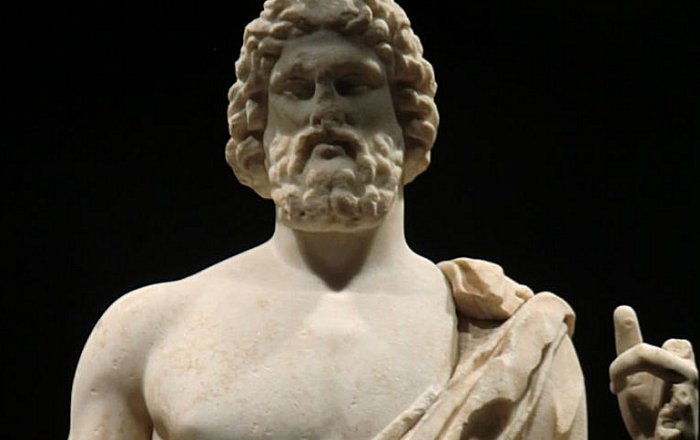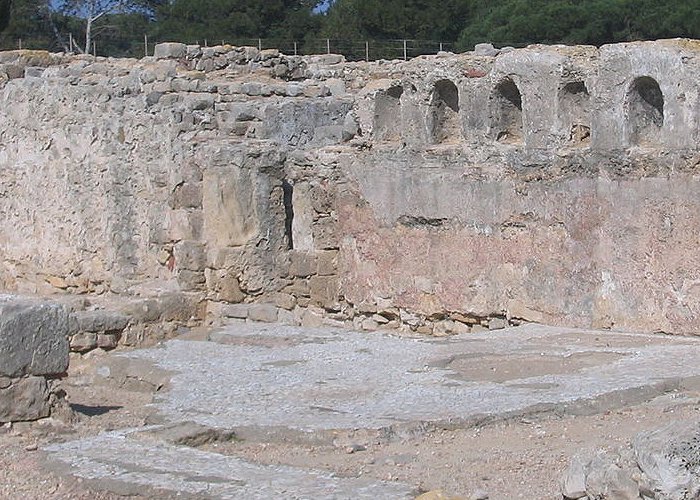Ancient City Empuries (Emporiae) With Best Greek Ruins Located Outside Of Greece
A. Sutherland - AncientPages.com - The 2,500-year-old Empuries (also Emporiae) site on the Costa Brava was built in 575 BC. It was a Greek and, later, a Roman colony located on the northeastern coast of Spain.
Left: Emporiae - Remains of the Roman wall in the ancient city. Image credit: David Mateos García - CC BY 2.0; Right: Roman gate wall in the city of Empuriae, founded in 575 BC. Image credit: Marta A A - CC BY-SA 3.0.
The city of Emporiae, was founded in 575 BC by Ionian Greek colonists from Phocaea (Phocaia) under the name 'Emporion, which means 'market.' It developed under the strong influence of the two most prominent cultures of the ancient world: Greek and Roman.
However, the site is considered the home of the best ancient Greek ruins located outside of Greece.
Recently, Spanish archaeologists unearthed the remains of a large temple in Catalonia, northeast of Spain. The discovered structure was, according to researchers, used for worship approximately 2,500 years ago. The temple was dedicated to Demeter, the Greek goddess of fertility and fertility.
She was the goddess of agriculture and mother to the goddess Persephone, a daughter of Zeus. She provided nutrition to everyone on earth – and, to help man, introduced him to wheat.
Demeter. Coarse-grained marble, Roman artwork; the head is a modern restoration. Image credit: Marie-Lan Nguyen - CC BY 2.5
The temple – probably built in the 6th century BC - was rebuilt several times. The building functioned until at least the 3rd century BC, thanks to these preservations.
Although now in ruins, it was once an essential part of the ancient city of Emporiae, located on the Mediterranean coast of Catalonia, on the Costa Brava. In the beginning, the town was occupied by the ancient Greeks.
The Greek sculpture of Asclepius - dated to the 2nd century BC. Image credit: Museum of Archeology of Catalonia, Empúries.
This marble statue associated with the city of Empúries represents a male deity with a beard and cloak. His attributes are - according to tradition- identified with Asclepius, the Greek god of medicine. It was sculpted in two parts that fit together at the torso. It comes from a Hellenistic workshop in the eastern Mediterranean and would have arrived at the end of the 2nd century BC.
It is worth noting that the different parts of this particular statue were found, in Empúries, in 1909, on the upper terrace of the sanctuaries, located to the south of the Greek city.
The iconographic features of the statue, together with the fragments of the representation of a serpent found in the place, contributed much for researchers, who could identify it with the Greek god Asclepius, the Roman Aesculapius.
Paleochristian Basilica – Empúries. Image credit: CC BY 2.0
Later, Emporiae became more and more of a Roman city due to the early presence of the Romans and their troops that landed there in 219 BC. It was a historical event strongly connected with Hannibal's march toward Italy.
For the Roman troops conducting their operations in Spain, the city of Emporiae has become a vital transshipment point on the transport route from Italy. Under Emperor Julius Caesar, Emporiae gained the status of a Roman colony in 45 BC.
Emporiae coins, 5th-1st century BC. Image credit: PHGCOM - CC BY-SA 3.0
After a period of prosperity and uninterrupted development, about the 1st/2nd century AD, an economic collapse took place. A general crisis caused by the loss of the city's leading role on the Western trade route, certainly played an important role.
However, Emporiae continued as a more modest, walled settlement well into the early Christian period. From the 6th century, the city became the diocese's seat and later the local Principality's capital. The end of the ancient city had to come, so it happened.
It was caused at the beginning of the 8th century by the invasion of the Arabs. Sometime in the early Middle Ages, the city was abandoned due to its unprotected location for looting from the sea.
Today, Empuries is one of the important archaeological sites in Catalonia. Once, it was a crucial element of connection with other Mediterranean areas of the Iberian Peninsula.
The preserved remains shed light on the city's ancient past, which still has much to offer. Among many Greek and Roman ruins, there is a temple dedicated to the Hellenistic-Egyptian god, Serapis, and another one that honored Artemis of Ephesus).
Written by – A. Sutherland - AncientPages.com Senior Staff Writer
Copyright © AncientPages.com All rights reserved. This material may not be published, broadcast, rewritten or redistributed in whole or part without the express written permission of AncientPages.com
More From Ancient Pages
-
 Varahamihira: Indian Sage And One Of The Greatest Minds Of All Time
Featured Stories | Sep 13, 2016
Varahamihira: Indian Sage And One Of The Greatest Minds Of All Time
Featured Stories | Sep 13, 2016 -
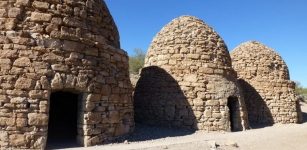 Arizona’s Enigmatic Beehive-Shaped Stone Coke Ovens
Featured Stories | Jul 15, 2023
Arizona’s Enigmatic Beehive-Shaped Stone Coke Ovens
Featured Stories | Jul 15, 2023 -
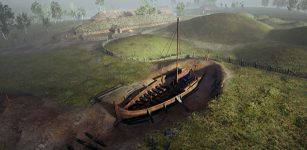 Archaeologists Reveal 12 Exciting Finds From The Gjellestad Viking Ship Dig
Archaeology | May 28, 2022
Archaeologists Reveal 12 Exciting Finds From The Gjellestad Viking Ship Dig
Archaeology | May 28, 2022 -
 The Face Of The Amarakarei – Remarkable Enormous Face Caved Into Stone Cliffs In Peru
Places | Nov 20, 2015
The Face Of The Amarakarei – Remarkable Enormous Face Caved Into Stone Cliffs In Peru
Places | Nov 20, 2015 -
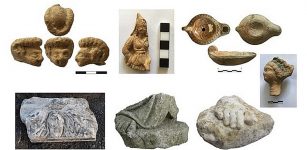 Excavations Of Ancient Theater In 2,400-Year-Old City Of Smyrna, Turkey
Archaeology | Feb 13, 2019
Excavations Of Ancient Theater In 2,400-Year-Old City Of Smyrna, Turkey
Archaeology | Feb 13, 2019 -
 Earliest Systematic Coal Exploitation For Fuel Goes Back To ~3600 B.P.
Archaeoastronomy | Aug 2, 2023
Earliest Systematic Coal Exploitation For Fuel Goes Back To ~3600 B.P.
Archaeoastronomy | Aug 2, 2023 -
 Roman Forum (‘Forum Romanum’) – The Heart Of Ancient Rome
Featured Stories | Aug 5, 2019
Roman Forum (‘Forum Romanum’) – The Heart Of Ancient Rome
Featured Stories | Aug 5, 2019 -
 First Evidence Of Canoe Burial With Remains Of A Woman Discovered In Argentinian Patagonia
Archaeology | Aug 27, 2022
First Evidence Of Canoe Burial With Remains Of A Woman Discovered In Argentinian Patagonia
Archaeology | Aug 27, 2022 -
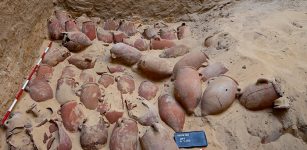 Largest Ancient Embalming Cachette Ever Found Unearthed At Abusir, Egypt
Archaeology | Feb 20, 2022
Largest Ancient Embalming Cachette Ever Found Unearthed At Abusir, Egypt
Archaeology | Feb 20, 2022 -
 Those Who Mysteriously Disappeared To A World Beyond Human Understanding
Featured Stories | Apr 30, 2019
Those Who Mysteriously Disappeared To A World Beyond Human Understanding
Featured Stories | Apr 30, 2019 -
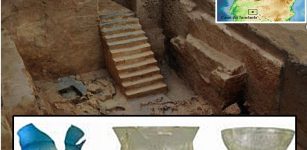 Archaeologists Highlight The Tartessos Culture’s Sustainable Construction Skills
Archaeology | Oct 4, 2024
Archaeologists Highlight The Tartessos Culture’s Sustainable Construction Skills
Archaeology | Oct 4, 2024 -
 Exceptional Discovery: A 9,000-Year-Old Stone Workshop Unearthed In Senegal Sheds Light On West Africa’s Prehistory
Archaeology | Sep 8, 2025
Exceptional Discovery: A 9,000-Year-Old Stone Workshop Unearthed In Senegal Sheds Light On West Africa’s Prehistory
Archaeology | Sep 8, 2025 -
 Neolithic Boats At La Marmotta Reveal People Used Advanced Nautical Technology 7,000 Years Ago
Archaeology | Mar 22, 2024
Neolithic Boats At La Marmotta Reveal People Used Advanced Nautical Technology 7,000 Years Ago
Archaeology | Mar 22, 2024 -
 Ancient Village Of Zalipie Where Flowers Are Painted On All Houses
Ancient Traditions And Customs | May 29, 2019
Ancient Village Of Zalipie Where Flowers Are Painted On All Houses
Ancient Traditions And Customs | May 29, 2019 -
 Oldest Modern Human Genome Identified With The Help Of Neanderthal Ancestry
Archaeology | Apr 14, 2021
Oldest Modern Human Genome Identified With The Help Of Neanderthal Ancestry
Archaeology | Apr 14, 2021 -
 Hiawatha And The Legendary Great Peacemaker – Native American Heroes Who Founded The League Of The Iroquois
Featured Stories | Feb 25, 2019
Hiawatha And The Legendary Great Peacemaker – Native American Heroes Who Founded The League Of The Iroquois
Featured Stories | Feb 25, 2019 -
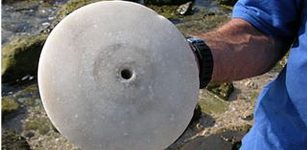 A 2,500-Year-Old Marble Disc, Designed To Protect Ancient Ships And Ward Off The Evil Eye – Discovered
Archaeology | Aug 4, 2023
A 2,500-Year-Old Marble Disc, Designed To Protect Ancient Ships And Ward Off The Evil Eye – Discovered
Archaeology | Aug 4, 2023 -
 Apollo – Loved And Feared Greek God Of Divination And Prophecy Who Was Also Seer Of Zeus
Featured Stories | Feb 6, 2019
Apollo – Loved And Feared Greek God Of Divination And Prophecy Who Was Also Seer Of Zeus
Featured Stories | Feb 6, 2019 -
 Forgotten Ancient Empire That Extended Far Beyond America To Iceland And Its Mysterious Inscriptions
Ancient Mysteries | May 6, 2021
Forgotten Ancient Empire That Extended Far Beyond America To Iceland And Its Mysterious Inscriptions
Ancient Mysteries | May 6, 2021 -
 Large-Scale DNA Study Traces 37,000 Years of Disease History
Archaeology | Jul 18, 2025
Large-Scale DNA Study Traces 37,000 Years of Disease History
Archaeology | Jul 18, 2025

